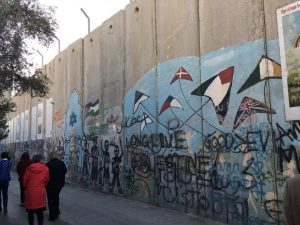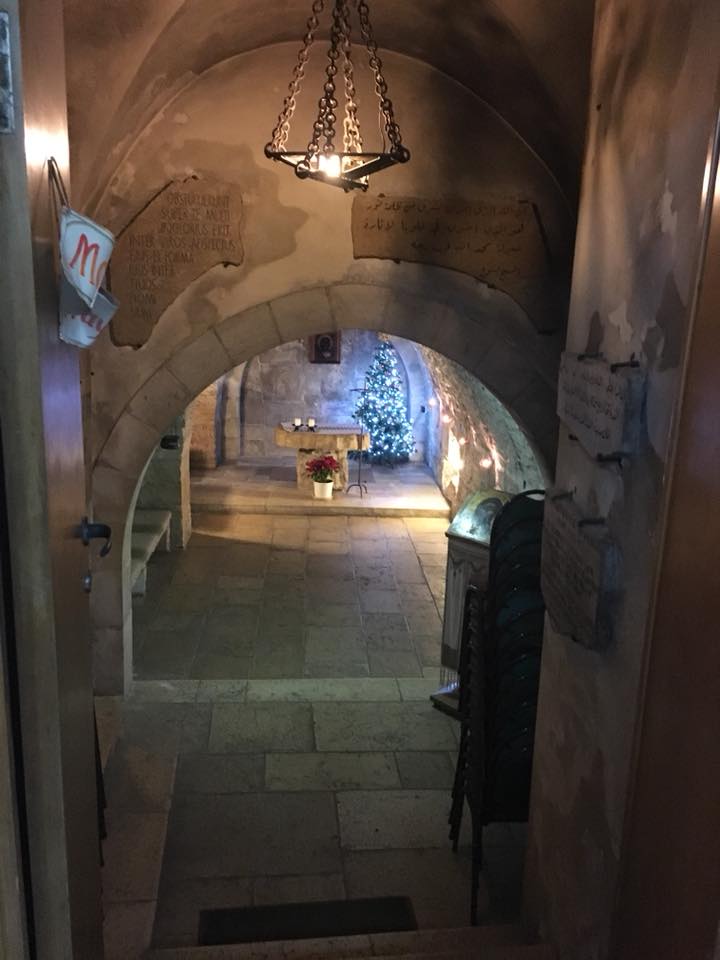The Revd Rosalind C Hughes spoke to the Revd Mary C. Carson and the Revd Gayle Catinella after their pre-Christmas pilgrimage to the Holy Land. All photographs courtesy of Mary Carson and Gayle Catinella
On December 7, 2017, as Donald Trump was announcing his decision officially to recognize Jerusalem as the capital of Israel, two Episcopal priests were travelling on the first leg of their flight from Ohio to join a pilgrimage in the Holy Land organized out of Washington National Cathedral. The Revd Mary C. Carson, Priest-in-Charge of St James’ Episcopal Church, Cincinnati, Ohio, and the Revd Gayle Catinella, Rector of St John’s Episcopal Church, Youngstown, Ohio, would meet up with the rest of the group at St George’s Anglican Cathedral in East Jerusalem the following day, just as US Embassies around the region were issuing cautionary advice for Americans at large in areas likely to be provoked to unrest by Trump’s pronouncements.

The timing was not ideal, but, as Catinella observed, that is what the region is like: unpredictable, and perennially volatile. Carson recalled that her first visit ended three years ago as Israel was beginning the first raids of the 2014 Gaza war. The tension was obvious both times, Carson said, although it felt different this time, when the anger was coming from the occupied instead of the occupiers.
The “politics were spiritually helpful,” to Catinella. She has studied the Gospels enough to recognize the language of oppression and occupation, but, she said, she only really got it when she was there in East Jerusalem among people whose movement is restricted, whose families’ access to education and medicine is undermined. She had a new grasp of the fire beneath the disciples’ heat for political action. She also understood that a people who had experienced such conditions might do anything to stop it from happening again, leading to a vicious cycle of occupation and oppression.

In terms of their personal safety, both women agreed that their local guides were adamant that the people in their charge would be kept safe and secure. They were encouraged to check in regularly on social media to let their circles of contacts know that all was well. Although there were posters of celebration and protest around the city, actual unrest tended to be localized and did not affect the thirty-seven strong group of Episcopal tourists; although Carson did recognize one location in a news report broadcast while the group was away in Nazareth, and one East Jerusalem bookstore that she visited had added a message to its Christmas tree, saying, “The lights are off on our Christmas tree. Thank you USA.”

A meeting with Archbishop Suheil Dawani was also affected – rescheduled and abbreviated as he had been summoned to a council with other ecumenical leaders by King Abdullah II of Jordan, who has oversight of religious sites in the occupied West Bank.
In Nazareth, in the heart of Israel’s Galilee region, the pilgrims fell into conversation with the owner of a street café. One of the Americans was admiring his electric meat shaver as it sliced gyro meat from a large body of lamb rotating in the window. The local man asked them about their views of Trump’s presidency and foreign policy. Only after a frank and uninhibited exchange did they notice the young Israeli soldier standing on the sidewalk a few feet away, machine gun pointed at the ground. They wondered if they should be more discreet in their public conversation.

At the other end of the journey familiar to devotees of the nativity narrative, the group visited Bethlehem. There, they met with Lutheran Palestinians living in the occupied West Bank and wondering if the wider world has forgotten that there are Christians in the country, too; although they are bleeding out of the holy lands at an alarming rate, according to those left behind.
Throughout the visit, they heard the oft-repeated line, “Jerusalem isn’t Trump’s to give away.” The counterpoint heard from the Palestinian Christians they spoke with was, “Jerusalem is yours, too.” The status of the city as a universal place of pilgrimage and devotion is at odds with its vulnerability as a prize in geopolitics. I wonder if it has become, in a way, our modern Tower of Babel.

Carson noted that more than in any other place, and more so than during her earlier visit to the holy city, she was moved at every turn to pray for the peace of Jerusalem. She was somewhat disheartened by the decline in peace and escalation of tension since her last visit: even the street vendors, she said, seemed more desperate and aggressive; but while the prospects for peace seem limited in the short term, she cites the Palestinian Christians, holding on to hope against hope, as examples to follow for the long haul.
Catinella wonders if hope is a “privileged emotion.” She compares the obstacles to hope among an occupied people to the problems of racism in our own country: unequal access, unequal power. She didn’t hear or see much hope among the Palestinians, she said, Christian or Muslim. Politically, she doesn’t see a way forward for the peace process in the near to medium term.
Still, the holy city now has a claim upon her hope that it didn’t have before. “Having been there, I have a stake in I now, and a love for it, in a way that I didn’t before.” It was that love which drew Carson back a second time, and both women are already planning their next return.
“If I forget you, O Jerusalem, let my right hand forget its skill.” (Psalm 137:5, BCP)

